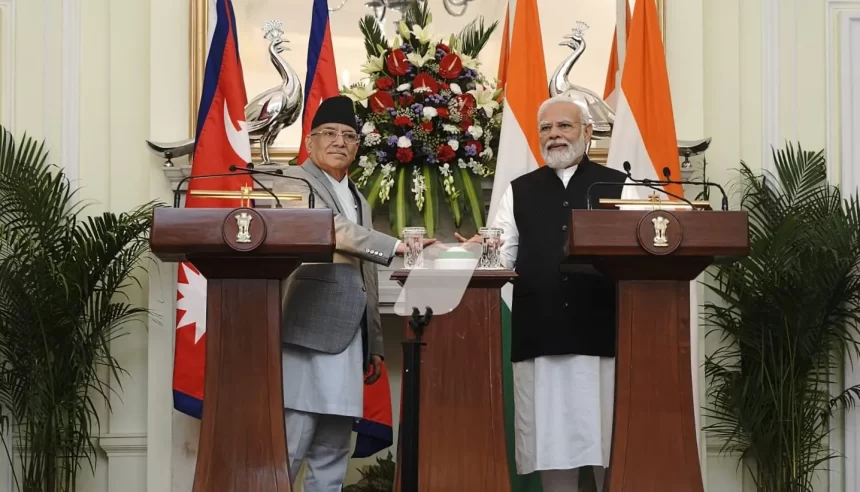Prime Minister Narendra Modi and his Nepal counterpart Pushpa Kamal Dahal signed seven agreements between the two nations Thursday afternoon after a bilateral meeting at Hyderabad House in Delhi. Recalling his first visit to Nepal – in 2014, after he became PM for the first time – Modi said he had then given a ‘HIT formula’ to improve India-Nepal relations and that today’s agreements would help that relationship become a ‘super HIT’. “I remember… nine years ago, in 2014, I made my first visit to Nepal. At that time I had given a ‘hit’ formula for India-Nepal relations – Highways, I-ways, and Trans-ways. I said we will establish such contacts that our borders do not become barriers. Today, the Nepal PM and I have taken many important decisions to make our partnership a super HIT,” Modi said. “We will continue to strive to take India-Nepal ties to Himalayan heights.”
On his first bilateral trip abroad since assuming office in December last year, the Nepal PM said he had extended a ‘cordial invitation’ to Modi to visit his country.
“This is my fourth visit to India. The relationship between India and Nepal is age-old. Today we discussed over steps to strengthen the ties between both nations. We also jointly launched many ground-breaking projects,” Dahal said.
The two prime ministers signed key agreements that include new rail links to increase physical connectivity and a long-term deal expected to strengthen the electricity-generating sectors of each country
These are in line with the expectations from the Nepal PM’s visit. Cooperation in the power sector was designated a ‘key focus area’ by sources privy to the discussions; it was pointed out that Nepal exports over 450 MW of electricity to IndiaIndian firms have shown interest in developing hydropower projects in Nepal and was part of a summit in Nepal in April, at which several participated. ndia has also built several hydroelectric projects, like Pokhara (1 MW), Trisuli (21 MW), Western Gandak (15 MW), and Devighat (14.1 MW) etc.
Further, agreements have been signed between Satluj Jal Vidyut Nigam Ltd and the Nepal Electricity Authority for the development and implementation of the 490.2 MW Arun-4 hydropower project.
The project is expected to generate electricity for Nepal and India as well as Bangladesh. SJVN has a 51 per cent share and the NEA has 49 per cent.
Indian firms have been invited to invest in the West Seti Hydropower ProjectModi and Dahal virtually inaugurated integrated check posts at Rupaidiha in India and Nepalgunj in Nepal and flagged off (virtually again) a cargo train from Bihar to Nepal. The Nepal PM had also been expected to discuss the opening of more air travel routes. Religious and cultural ties between India and Nepal are old and strong. To further strengthen this, we have decided that projects related to the Ramayana Circuit – one of 15 tourism circuits identified for development – should be expedited,” Modi said. Religious and cultural ties between India and Nepal are old and strong. To further strengthen this, we have decided that projects related to the Ramayana Circuit – one of 15 tourism circuits identified for development – should be expedited,” Modi said. Nepal is important for India in the context of its overall strategic interests in the region, and the leaders of the two countries have often noted the age-old ‘roti beti’ relationship, which refers to cross-border marriages between people of the two countries. The country shares a border of over 1,850 km with five Indian states – Sikkim, West Bengal, Bihar, Uttar Pradesh and Uttarakhand. Land-locked Nepal relies heavily on India for the transportation of goods and services and access to the sea is through India.
The India-Nepal Treaty of Peace and Friendship of 1950 forms the bedrock of the special relations between the two countries


Leave a Reply